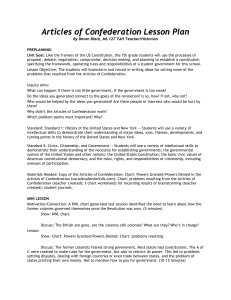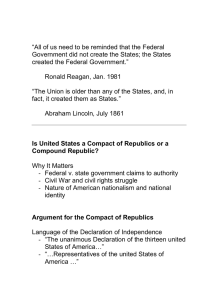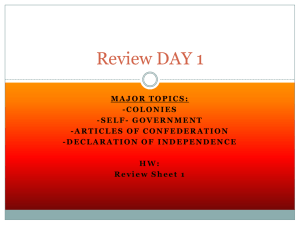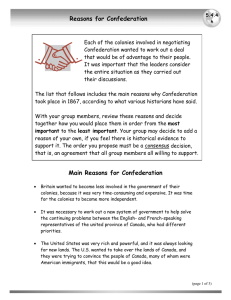The American Revolution as a Constitutional Struggle
advertisement
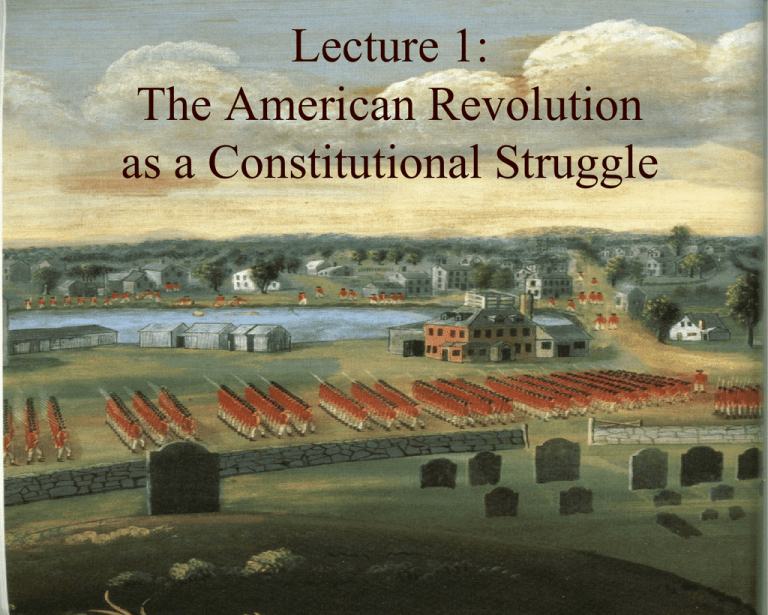
Lecture 1: The American Revolution as a Constitutional Struggle French & Indian War (1755-1763) Background Expansion of British colonies King George’s War The Albany Conference French & Indian War (1755-1763) Treaty of Paris, 1763 France depleted Spain British gains Proclamation Line of 1763 French & Indian War (1755-1763) Results: The colonies after the war Depression Proclamation line Wartime experience Unity among the colonies The Road to War British policy changes Standing army Soldiers Jobs Colonies to pay George Grenville’s acts Sugar Act 1763 Currency Act 1764 Stamp Act, 1765 Reaction: riots Sons of Liberty Repealed The Road to War Heightened tension Declaratory Act Charles Townshend Townshend Acts 1769, Virginia Resolutions Boston Massacre, 1770 Committee of Correspondence The Road to War Heightened tension Boston Tea Party, 1773 Coercive Acts Continental Congress(es), 1774 & 1775 Lexington & Concord, Apr. 14, 1775 Thomas Paine, Common Sense Declaration of Independence, Thomas Jefferson, July 4, 1776 The Declaration of Independence When in the course of human events, it becomes necessary for one people to dissolve the political bands which have connected them with another, and to assume among the powers of the earth, the separate and equal station to which the Laws of Nature and of Nature’s God entitle them, a decent respect to the opinions of mankind requires that they should declare the causes which impel them to the separation. The Declaration of Independence We hold these truths to be self-evident, that all men are created equal, that they are endowed by their Creator with certain unalienable Rights, that among these are Life, Liberty, and the pursuit of Happiness. That to secure these rights, Governments are instituted among Men, deriving their just powers from the consent of the governed… The War for Independence The Revolution for the Nation “13 clocks striking in unison” Divisions between the states Localism vs. Nationalism States vs. national govt. Large states vs. small Landed states vs. landless North vs. South The Revolution for the Nation Ties that unite the nation? Language? Noah Webster Territory? Communications? Religion? Traditions? Currency? “What then is the American?” American mythology Ideal of equality Ideal of self-made man Ideal of “melting pot” “Rugged individualism” We are united by great and frightening challenges The Articles of Confederation Powers of Congress: Wage war Foreign affairs Boundary disputes Indian affairs Post office Powers it lacked: Raise troops Levy taxes The Articles of Confederation Article 1: “The United States of America” Article 5: Freedom of speech Article 4: National citizenship Article 9: Unity of the colonies Article 2: States’ rights The Articles of Confederation Weaknesses: Single house in the legislature No separate judicial branch Could not impose taxes Changes require unanimous support Article 8: paying for war The Articles of Confederation The situation becomes desperate: We are bankrupt Taxation Money disputes The Articles of Confederation The situation becomes desperate: Shay’s Rebellion


